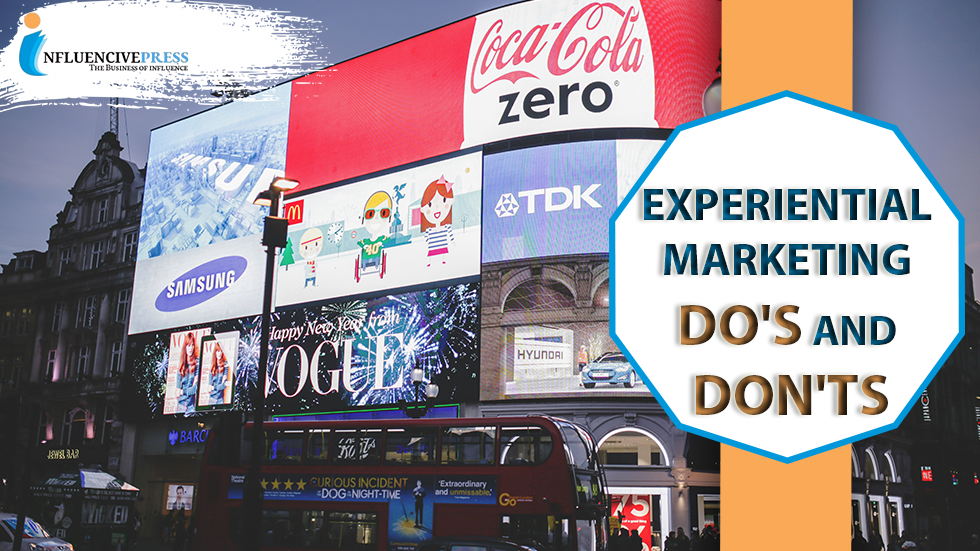Experiential Marketing: Do’s and Don’ts
Experiential Marketing is a type of marketing strategy that builds on the engagement of the five senses. Primarily an online-based marketing strategy, experiential marketing is focused on shaping up brand awareness via a face-to-face connection with potential customers. It helps in leveling insights and reviews of customers that are not possible with traditional modes of marketing. Experiential Marketing blends user interaction within marketing opportunities to raise product traction and level insightful experiences with the brand. It is incredibly helpful in establishing a standardized product value that provides invaluable input for further improvements.
As with any other marketing strategy, Experiential Marketing has specific do’s and don’t’s that need to be kept in mind while planning strategies and implementing them in the market. Let us divide the positives first, and then lead on the do not regarding Experiential Marketing respectively.
• Do set a final budget: Experiential Marketing is built on particular set budgets within the marketing strategies. The brand that advertises the product must set a definitive account set aside in building the experiential marketing modules. One must not go overboard while deciding on this budget. The main aim of prescribing a set budget is not to curb all the market reactions’ engagement. It must set an achievable account that would cover all the planning and implementation costs without any excess leveraged to it. Instead, it is made with the promise of focusing on the necessities of each company specifically. Since each company varies from the other in various ways, it is wise to acknowledge the standard costs and expected revenues from such a strategy. Going overboard or expecting high returns without considering its market reactions would not be a wise decision. Hence, the need for a sustainable budget is particularly required.
• Do plan marketing events: A successful experiential marketing strategy thrives on planning and implementing events. During this organizational structure, one must retain the data of previous clients and customers’ data and utilize these details to plan future strategies. The right marketing agency will detect all the flaws present previously and make significant changes to raise the engagement the following time. Planning of events must be researched according to the market’s seasonal demands so that the arrangement is vital. Eliciting the maximum number of responses from a planned marketing event must be the main reason behind the planning. Additional charges are negotiable only if they do not create a significant amount of changes to the existing plans.
• Do understand the brand: Any experiential marketing strategy is mainly exercised to build on the brand name at the end of the day. It is the brand name that matters the most. Hence, it is incredibly helpful in understanding the brand. A team must research the brand to understand the market demand’s priorities at the very beginning. Consequently, experiential marketing strategies must be designed to establish the brand in a long-term relationship with the market. Assist in understanding the brand’s motto, share the research work into different segments within the brand, and create strategies that cater beyond the target audience at hand. It will help in securing a long-term engagement of the brand with the market.
• Do set achievable goals: Every brand sets a marketing strategy to achieve a favorable result at the end of the day. In the consumer market, earning this result might take months, and in some cases, years to fully grasp the engagement value. Hence, it is always beneficial to organize an experiential strategy that elicits a response that takes lesser time but with a favorable outcome. The advertisements must record the reviews, take face-to-face user inputs, and then solidify them into the datasheet. These methods will help in realizing the goals set at the beginning of the strategy. Achieving these results may differ from season to season and from company to company. Therefore, it is always helpful to set achievable goals that take less time and investment but fetch favorable outcomes.
• Don’t decide on any strategy based on price: Experiential marketing strategies rely heavily on market rates and service providers. With every other company opting for experiential marketing strategies, the offers and sales are often set at a considerable competition simultaneously. As a result, lucrative offers might increase to raise user interaction. Even with these offers on display, the service quality sets a product apart from another company. Hence, it is essential to decide on a fixed price for these offers at the show. Opting for a marketing strategy just based on price can cause a significant backfire on the brand. As a result, set designs that require cost-effective prices bring in impressive levels of interaction between a product and the user. Choose work based on these results.
• Don’t neglect pre-and post– strategy changes: Each brand must take careful note of the pre-and post- experiential strategy details. Before the marketing strategy is mainly exercised on the brand, a considerable amount of effort must be made in accounting for the existing user interface with the brand. After the procedure is implemented, take note of the trends that have taken place. Social media marketing strategies come to play here. It is essential to recognize the buzz, follow up with the customers as soon as possible, and keep careful track records of their feedback. This mechanism must never be understated in realizing the goals set for the experiential marketing strategy for a particular brand name. Pre- and post-record reminders are essential for a successful outcome calculation with regards to the brand.
• Don’t underestimate your target audience: For a marketing strategy essentially built on specific audience reactions, the brand must never underestimate their reactions as guaranteed sources of exercising outcome. The challenge is to generate an interface that challenges existing data by creating exciting and unique sponsorships and deals. The activities planned and designed must not be persuasive in their reactions from the target audience at the very best. An objective clarity in response is what should be aimed at, rather than an appropriate one.

